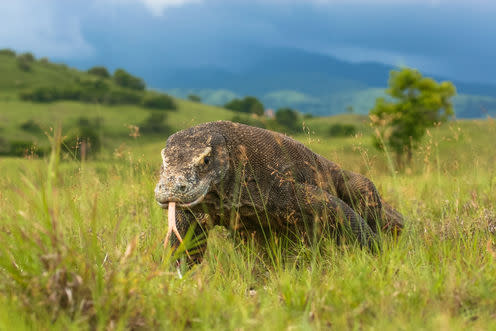Monitor lizard venom could be used to treat human blood clots

To be venomous, an animal – or plant, or even bacterium – must have a toxic secretion and a mechanism for delivering it into another animal, in order to feed or defend itself. Venoms tend to be highly complex mixtures of molecules containing both toxins and non-toxic components, and much research has gone into understanding the composition of venoms from many different species.
Because venoms are essentially pools of molecules that have evolved to alter the physiology of other animals – whether they be predators or prey – they are excellent candidates for the development of new medicinal drugs. This follows from the fact that most physiological systems are carefully balanced at some optimal point. For instance, if blood pressure is too high, a person will suffer hypertension, but if it is too low they will suffer from hypotension.
Some animal venoms have evolved to quickly decrease blood pressure, which can cause shock in a prey animal and immobilise it so it can be eaten. However, if we can identify the toxins which lead to the drop in blood pressure, we can perhaps use them to lower blood pressure in people with hypertension. The highly variable nature of venom between, and even within, species means that there are a great many potential drugs out there.
Kill or cure
The development of drugs from venoms has already proven successful in the past. At least six venom-derived drugs are currently on the market in the US. Perhaps the best known example is the drug Capoten, which is derived from a South American species of pit viper, Bothrops jararaca. Capoten is an ACE inhibitor medication (which block the body from producing a chemical called angiotensin II, which in turn narrows the blood vessels) that is used to treat conditions such as hypertension.
Similarly, the drug Byetta is derived from the venom of the Gila monster (Heloderma suspectum), a venomous lizard. Byetta is used to treat type 2 diabetes: it increases insulin secretion by the pancreas, and slows glucose absorption in the gut. Together, this lowers blood sugar levels and reduces appetite.

Monitor lizards – a group which includes the famous Komodo dragon – have traditionally not been considered to have venom. However, recent work has suggested that they are indeed venomous, based on the presence of sophisticated glands in the lower jaw, which produce similar toxins to those found in other lizards and snakes known to be venomous.
Nevertheless, some biologists have disagreed with these findings, in part arguing that the “venom” is not important to these lizards for their predation or defence. But our new paper has contributed more data that suggests that not only are these lizards venomous, but that they may have toxins which have potential to treat blood disorders in humans.
Toxins and drug development
For our research, we examined 16 species of monitor lizard species and found that all had venoms which contained toxins similar to some of those found in venomous snakes and Gila monsters.
In addition, each species had a different subset of toxins. This suggests that natural selection is actively favouring diversification of the toxins, and that these molecules are doing something important to the lizard’s evolutionary fitness.
We also demonstrated that – in addition to effects previously documented from monitor lizard venom – at least some venoms can cause muscle spasms, and all the venoms destroyed the blood’s clotting ability.
The effects that lizard venom has on the blood is due to toxins which cleave – damage by “cutting” – fibrinogen, which is necessary for clot formation. We found that how quickly fibrinogen was cleaved, and which parts of fibrinogen were affected, varied between monitor lizard species. This means that there are several different varieties of toxins which contribute to stopping blood from clotting. In prey, this would quickly cause loss of blood, resulting in weakness and shock.
As many human medical conditions are caused by blood clots occurring where it shouldn’t, such as many heart attacks, strokes, and thromboses, lizard venom could potentially be a treasure trove of previously unexplored toxins that stop blood clots from happening. As the idea of venom in monitor lizards has been previously disregarded, we now have the opportunity to develop new drugs from the toxins in monitor lizard venom to treat blood clotting disorders.
The existence of any drugs that may arise from these venoms is still many years off, but it just goes to show that medicines can come from the unlikeliest of sources – and that future studies on monitor lizard venom may bring large benefits for us all.
This article was originally published on The Conversation. Read the original article.

Kevin Arbuckle does not work for, consult, own shares in or receive funding from any company or organisation that would benefit from this article, and has disclosed no relevant affiliations beyond the academic appointment above.

 Yahoo News
Yahoo News 
